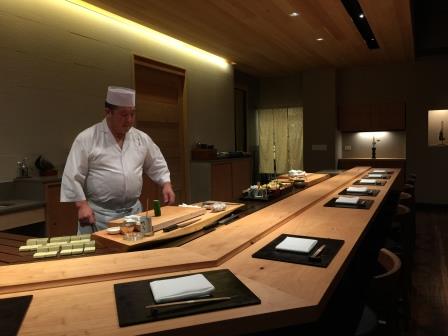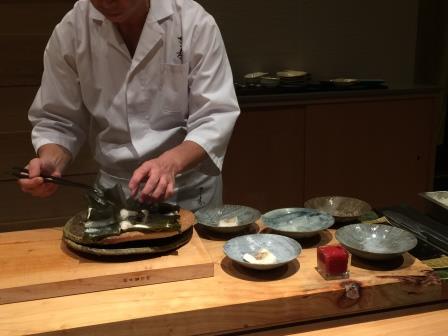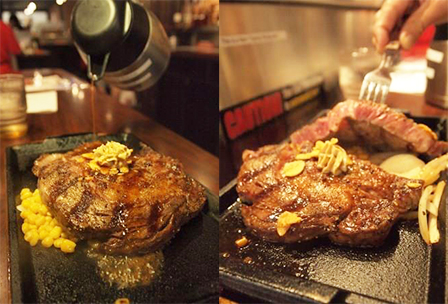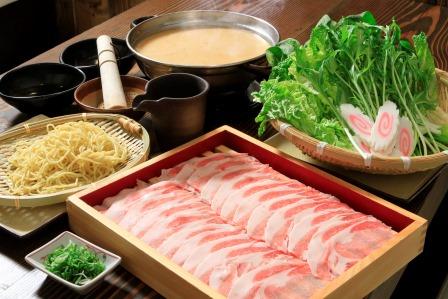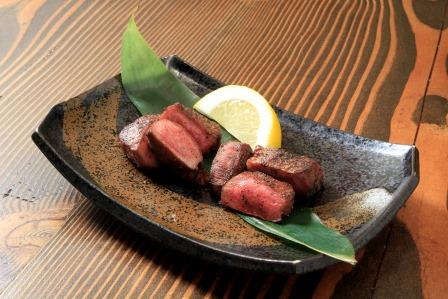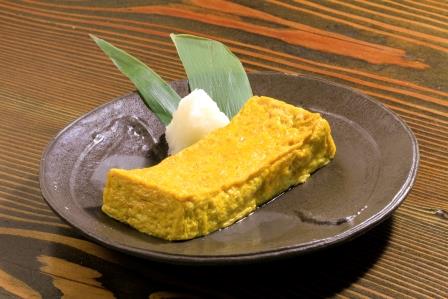True Edomae-Style Sushi created by an experienced artisan
By Eri Shimizu
In the Mission District where many restaurants loved by gourmet eaters gather, an authentic omakase-style Edomae sushi restaurant, “Sasaki”, to which many such foodies give attention, opened toward the end of last year. This restaurant that is located on Harrison Street, just off the center of the District, is a compilation of the achievements of Masaki Sasaki, an experienced sushi chef who has helped Japanese restaurants in San Francisco gain a Michelin star or a Bib Gourmand status. There is no obvious sign board in front of the
restaurant, but only a small sign near the door. However, once you open the door, a sophisticated-looking space that resembles a high-end sushi restaurant in Ginza opens up.
Mr. Sasaki has been building his career as a sushi chef for nearly 40 years in the US. After working in notable restaurants in New York, the Bay Area, etc., he opened the sushi restaurant, Maruya, in the Mission District in 2013 with a partner, and gained Michelin star status. Only a year later, he left Maruya to pursue his own ideal sushi making style, and got involved in the launching of some popular restaurants in the news such as “Omakase” and “Delage”, as a sushi consultant. This is the first restaurant owned and managed by Mr. Sasaki, where you can taste authentic non-Americanized Edomae-style sushi.
They serve only one course menu at $180. The course consists of 3 parts starting with 3 or 4 kinds of small appetizers followed by 14 pieces of Nigiri-sushi, Akadashi miso soup, and dessert. Mr. Sasaki says that he does not serve assorted sashimi, meat dishes or roll sushi. In the course which is full of his particularity, a bite-size appetizer in a ceramic bowl is served first, and then Nigiri-sushi of seasoned tuna (which is the base of the Edomae-style sushi) is served. Red-meat tuna’s umami is enhanced when marinated, and its texture is viscous and rich. For the sushi rice to match such flavor, red vinegar made with aged sake leek is used. Red vinegar that has mellower umami compared to rice vinegar is typically used for Edomae-sushi. No sugar is contained. He says that the most important thing in sushi making is not fish, but rice. It is unusual in the US that different sushi vinegar is used depending on the menu. For the middle part of the course, regular rice vinegar is used for the sushi rice for
delicate flavored whitemeat fish and shell fish toppings, and red vinegar rice is used for more fatty or silverskinned fish toppings. After the seasoned tuna, a few appetizers including steamed abalone and cooked octopus are served, and then the course moves to the main nigiri part. Generally, many restaurants tend to serve light-tasting dishes such as white-meat fish before serving more fatty and rich ingredients, but this restaurant starts with 4 pieces of rich, heavy tasting neta (fish toppings) sushi such as fatty tuna and splendid alfonsino on red-vinegared rice. Then, after the miso soup, 4 pieces of light-tasting sushi such as shell fish and vinegar-marinated red snapper are served followed by extra fatty tuna, anago, Japanese shad, and a hand-roll. To finish the course, 2 egg dishes, Japanese style thick omelet and grated shrimp omelet cake are served for you to enjoy until the very end of the course.
The characteristic of Edomaestyle sushi is its concentrated umami and taste of seafood which are created by carefully combined work of Kombu seaweed, salt, soy sauce, vinegar, etc. It is the technique developed by the wit of regular residents in Edo to cook locallycaught fish in the Tokyo Bay in the best way possible. The fish directly airtransported from Tsukiji are treated in the best way to concentrate its umami and to be preserved, and served in the most delicious state. Only 2 chefs, Sasaki and another kitchen chef, do all these preparations. It is understandable that the number of reservations are limited to 6 per day (18 on weekend with 3 rotation), dinner only. All the reservations are set at the same time, and everything starts at once when all the people have arrived. The rather low cypress wood counter designed specifically to make it easy to communicate with the customers does not have the usual refrigerated case. The ingredients are transported in a white wooden case from the kitchen in the back right at each change of the part of the course. The chef Sasaki explain each piece of
sushi they serve, and move the course smoothly in perfect harmony.
Sasaki’s aesthetic value is also reflected on the plates and bowls, and interior decorations. The plates and bowls are made by Mr. Yamanaka, Sasaki’s acquainted Buddhist temple priest in Odawara. Mr. Yamanaka’s creations are used at some San Franciscan Michelin-starred restaurants including Saison, Benu, and Manresa. Blackcolor plates are used for sushi so they stand out on the light-colored wooden counter. Besides carefully selected Japanese sake, champagne and wine that go with sushi are also offered. The $180 per course is not cheap, but the customers seem to understand the added values to the food, conversation with the artisan chef, performance, and ambience. I asked Mr. Sasaki about his future prospects. He wants to open a place like a hotel that serves specialty Japanese dishes. The legend of Edomae-style Sushi by an experienced artisan, Sasaki, who has been involved
in the history of food trend in the Bay Area for a long time has just begun.
ベテラン職人が作り出す真の江戸前鮨
食通に人気のレストランが軒を並べるミッション地区で、彼らが注目する本格的な江戸前寿司おまかせ店、「Sasaki ] が昨年の暮れオープンした。ミッションの中心から少しはずれたハリソンストリートに位置する同店は、サンフラ ンシスコの和食店をミシュラン星やビブグルマンに導いたベテラン寿司シェフ、佐々木 雅喜氏による集大成である。外観には 看板は無く、ドア部分に小さくのサインがあるのみ。しかし そのドアを開けると銀座の高級寿司店の ような洗練された空間が広が広がる。「Sasaki」は、純正の江戸前鮨のコースを味わう サンフランシスコ屈指のレストランだ。
佐々木氏はアメリカで寿司シェフとして40年近くキャリアを積んできた。ニューヨークやベイエリアの名店でシェフを務めた後、2013 年にはミッション地区に寿司店Maruya をパートナーと共にオープンしミシュランスターも獲得した。しかし自らの理想とする寿司スタイルを貫く為、1年後に同店を離れる。その後は寿司コンサルタントとして「Omakase」や「Delage」など、話題の店の立ち上げに携わってきた。そんな佐々木氏が今回初めて経営者となる店では、アメリカナイズされていない江戸前寿司が味わえる。
提供されるのは$180のおまかせ1コースのみ。3~4品のおつまみに続き、握り寿司14 貫、赤だし、デザートという3部構成。「刺身盛り合わせや肉料理、揚げ物、ロールは出さない」と佐々木氏。こだわりのコースは、陶器の小箱に入った一口前菜に続いて、江戸前の基本である漬けマグロの握りが出される。マグロの赤身は漬けにすることで旨みが際立ち、食感もねっとりと濃厚な味わいだ。そのフレーバーに合わせたシャリは熟成させた酒粕を原料とした赤酢を使用している。江戸前鮨では伝統的に赤酢が使われ、米酢に比べてまろやかな旨みがある。そのため砂糖は使用しない。「寿司の中で一番大事なのは魚ではなくシャリ」とすし酢を変えて提供する店は全米でも珍しい。コースの中ほどに出される白身や貝類など繊細な味には、通常の米酢を使用し、脂の乗ったネタや光り物には赤酢のシャリと使い分けている。漬けマグロの後は蒸し鮑や煮だこなどのつまみが数品続き、メインの握りに移行する。一般的には白身など味わいの薄いものから脂の乗ったネタへと移行する店が多いが、ここでは赤酢のシャリを合わせた中トロやキンメなど濃厚な魚の寿司4貫から始まる。そして吸い物の後、貝類や酢じめの春子鯛などのさっぱりした握りが4貫、その後再び赤酢のシャリで大トロや穴子、コハダ、手巻きと続く。締めに出される卵焼きは、卵のみの厚焼き卵とエビのすり身を使ったカステラ卵の2種類が提供され、最後まで楽しませてくれる。
江戸前鮨の特徴は昆布や塩、醤油、酢などを用いた「仕事」で魚の旨みや味わいを凝縮するところにある。東京湾で上がった魚をいかに保存し、美味しく食べるかという江戸庶民の知恵から始まった技だ。築地から直送された魚には全て「仕事」が施され、最も美味しい状態で提供される。佐々木氏ともう一人のキッチンスタッフの2人だけで行うのだから、1日限定ディナーのみ6席(2回転12 客)(週末は3回転で18 客)の予約のみというのもうなずける。予約時間は決まっており、全員が揃ったところで一斉にスタートする。客との対話がしやすいようにとあえて低めにデザインしたヒノキのカウンターの下には通常あるはずの冷蔵庫がない。握り寿司のネタはシャリを変えるタイミングと同時に奥のキッチンから白木のネタケースに入れて運ばれる。コースは佐々木氏の料理の説明と共に流れるように進んでいく。
器やインテリアにも佐々木氏の美学が反映される。器は知人の小田原の住職、山中氏の手によるもの。山中氏の器はSaison やBenu、Manresa といったSFのミシュラン星レストランでも使われている。鮨を乗せる「ゲタ」も白木のカウンターに映える黒の正方形スレートが使用されている。ドリンクメニューは、厳選した日本酒だけでなく、鮨に合うシャンパンやワインも提供。コースで$180は決して安くはないが、お客には料理だけではなく、職人との対話、演出、雰囲気を全て揃えた価値観は伝わっているようだ。佐々木氏に今後の展望を尋ねると、いつかは料理旅館のような宿を始めたいという。長年ベイエリアでトレンドの変遷に関わってきたベテラン職人、佐々木氏による「江戸前寿司」の新たな伝説が始まる。
SASAKI
2400 Harrison Street
San Francisco, CA 94110
(415) 828-1912
http://www.sasakisf.com/index.html
Tues.-Thurs./ 6:00pm-11:00pm
Fri.-Sat./ 5:30pm-11:00pm
Closed on Sunday and Monday
In the Mission District where many restaurants loved by gourmet eaters gather, an authentic omakase-style Edomae sushi restaurant, “Sasaki”, to which many such foodies give attention, opened toward the end of last year. This restaurant that is located on Harrison Street, just off the center of the District, is a compilation of the achievements of Masaki Sasaki, an experienced sushi chef who has helped Japanese restaurants in San Francisco gain a Michelin star or a Bib Gourmand status. There is no obvious sign board in front of the
restaurant, but only a small sign near the door. However, once you open the door, a sophisticated-looking space that resembles a high-end sushi restaurant in Ginza opens up.
Mr. Sasaki has been building his career as a sushi chef for nearly 40 years in the US. After working in notable restaurants in New York, the Bay Area, etc., he opened the sushi restaurant, Maruya, in the Mission District in 2013 with a partner, and gained Michelin star status. Only a year later, he left Maruya to pursue his own ideal sushi making style, and got involved in the launching of some popular restaurants in the news such as “Omakase” and “Delage”, as a sushi consultant. This is the first restaurant owned and managed by Mr. Sasaki, where you can taste authentic non-Americanized Edomae-style sushi.
They serve only one course menu at $180. The course consists of 3 parts starting with 3 or 4 kinds of small appetizers followed by 14 pieces of Nigiri-sushi, Akadashi miso soup, and dessert. Mr. Sasaki says that he does not serve assorted sashimi, meat dishes or roll sushi. In the course which is full of his particularity, a bite-size appetizer in a ceramic bowl is served first, and then Nigiri-sushi of seasoned tuna (which is the base of the Edomae-style sushi) is served. Red-meat tuna’s umami is enhanced when marinated, and its texture is viscous and rich. For the sushi rice to match such flavor, red vinegar made with aged sake leek is used. Red vinegar that has mellower umami compared to rice vinegar is typically used for Edomae-sushi. No sugar is contained. He says that the most important thing in sushi making is not fish, but rice. It is unusual in the US that different sushi vinegar is used depending on the menu. For the middle part of the course, regular rice vinegar is used for the sushi rice for
delicate flavored whitemeat fish and shell fish toppings, and red vinegar rice is used for more fatty or silverskinned fish toppings. After the seasoned tuna, a few appetizers including steamed abalone and cooked octopus are served, and then the course moves to the main nigiri part. Generally, many restaurants tend to serve light-tasting dishes such as white-meat fish before serving more fatty and rich ingredients, but this restaurant starts with 4 pieces of rich, heavy tasting neta (fish toppings) sushi such as fatty tuna and splendid alfonsino on red-vinegared rice. Then, after the miso soup, 4 pieces of light-tasting sushi such as shell fish and vinegar-marinated red snapper are served followed by extra fatty tuna, anago, Japanese shad, and a hand-roll. To finish the course, 2 egg dishes, Japanese style thick omelet and grated shrimp omelet cake are served for you to enjoy until the very end of the course.
The characteristic of Edomaestyle sushi is its concentrated umami and taste of seafood which are created by carefully combined work of Kombu seaweed, salt, soy sauce, vinegar, etc. It is the technique developed by the wit of regular residents in Edo to cook locallycaught fish in the Tokyo Bay in the best way possible. The fish directly airtransported from Tsukiji are treated in the best way to concentrate its umami and to be preserved, and served in the most delicious state. Only 2 chefs, Sasaki and another kitchen chef, do all these preparations. It is understandable that the number of reservations are limited to 6 per day (18 on weekend with 3 rotation), dinner only. All the reservations are set at the same time, and everything starts at once when all the people have arrived. The rather low cypress wood counter designed specifically to make it easy to communicate with the customers does not have the usual refrigerated case. The ingredients are transported in a white wooden case from the kitchen in the back right at each change of the part of the course. The chef Sasaki explain each piece of
sushi they serve, and move the course smoothly in perfect harmony.
Sasaki’s aesthetic value is also reflected on the plates and bowls, and interior decorations. The plates and bowls are made by Mr. Yamanaka, Sasaki’s acquainted Buddhist temple priest in Odawara. Mr. Yamanaka’s creations are used at some San Franciscan Michelin-starred restaurants including Saison, Benu, and Manresa. Blackcolor plates are used for sushi so they stand out on the light-colored wooden counter. Besides carefully selected Japanese sake, champagne and wine that go with sushi are also offered. The $180 per course is not cheap, but the customers seem to understand the added values to the food, conversation with the artisan chef, performance, and ambience. I asked Mr. Sasaki about his future prospects. He wants to open a place like a hotel that serves specialty Japanese dishes. The legend of Edomae-style Sushi by an experienced artisan, Sasaki, who has been involved
in the history of food trend in the Bay Area for a long time has just begun.
ベテラン職人が作り出す真の江戸前鮨
食通に人気のレストランが軒を並べるミッション地区で、彼らが注目する本格的な江戸前寿司おまかせ店、「Sasaki ] が昨年の暮れオープンした。ミッションの中心から少しはずれたハリソンストリートに位置する同店は、サンフラ ンシスコの和食店をミシュラン星やビブグルマンに導いたベテラン寿司シェフ、佐々木 雅喜氏による集大成である。外観には 看板は無く、ドア部分に小さくのサインがあるのみ。しかし そのドアを開けると銀座の高級寿司店の ような洗練された空間が広が広がる。「Sasaki」は、純正の江戸前鮨のコースを味わう サンフランシスコ屈指のレストランだ。
佐々木氏はアメリカで寿司シェフとして40年近くキャリアを積んできた。ニューヨークやベイエリアの名店でシェフを務めた後、2013 年にはミッション地区に寿司店Maruya をパートナーと共にオープンしミシュランスターも獲得した。しかし自らの理想とする寿司スタイルを貫く為、1年後に同店を離れる。その後は寿司コンサルタントとして「Omakase」や「Delage」など、話題の店の立ち上げに携わってきた。そんな佐々木氏が今回初めて経営者となる店では、アメリカナイズされていない江戸前寿司が味わえる。
提供されるのは$180のおまかせ1コースのみ。3~4品のおつまみに続き、握り寿司14 貫、赤だし、デザートという3部構成。「刺身盛り合わせや肉料理、揚げ物、ロールは出さない」と佐々木氏。こだわりのコースは、陶器の小箱に入った一口前菜に続いて、江戸前の基本である漬けマグロの握りが出される。マグロの赤身は漬けにすることで旨みが際立ち、食感もねっとりと濃厚な味わいだ。そのフレーバーに合わせたシャリは熟成させた酒粕を原料とした赤酢を使用している。江戸前鮨では伝統的に赤酢が使われ、米酢に比べてまろやかな旨みがある。そのため砂糖は使用しない。「寿司の中で一番大事なのは魚ではなくシャリ」とすし酢を変えて提供する店は全米でも珍しい。コースの中ほどに出される白身や貝類など繊細な味には、通常の米酢を使用し、脂の乗ったネタや光り物には赤酢のシャリと使い分けている。漬けマグロの後は蒸し鮑や煮だこなどのつまみが数品続き、メインの握りに移行する。一般的には白身など味わいの薄いものから脂の乗ったネタへと移行する店が多いが、ここでは赤酢のシャリを合わせた中トロやキンメなど濃厚な魚の寿司4貫から始まる。そして吸い物の後、貝類や酢じめの春子鯛などのさっぱりした握りが4貫、その後再び赤酢のシャリで大トロや穴子、コハダ、手巻きと続く。締めに出される卵焼きは、卵のみの厚焼き卵とエビのすり身を使ったカステラ卵の2種類が提供され、最後まで楽しませてくれる。
江戸前鮨の特徴は昆布や塩、醤油、酢などを用いた「仕事」で魚の旨みや味わいを凝縮するところにある。東京湾で上がった魚をいかに保存し、美味しく食べるかという江戸庶民の知恵から始まった技だ。築地から直送された魚には全て「仕事」が施され、最も美味しい状態で提供される。佐々木氏ともう一人のキッチンスタッフの2人だけで行うのだから、1日限定ディナーのみ6席(2回転12 客)(週末は3回転で18 客)の予約のみというのもうなずける。予約時間は決まっており、全員が揃ったところで一斉にスタートする。客との対話がしやすいようにとあえて低めにデザインしたヒノキのカウンターの下には通常あるはずの冷蔵庫がない。握り寿司のネタはシャリを変えるタイミングと同時に奥のキッチンから白木のネタケースに入れて運ばれる。コースは佐々木氏の料理の説明と共に流れるように進んでいく。
器やインテリアにも佐々木氏の美学が反映される。器は知人の小田原の住職、山中氏の手によるもの。山中氏の器はSaison やBenu、Manresa といったSFのミシュラン星レストランでも使われている。鮨を乗せる「ゲタ」も白木のカウンターに映える黒の正方形スレートが使用されている。ドリンクメニューは、厳選した日本酒だけでなく、鮨に合うシャンパンやワインも提供。コースで$180は決して安くはないが、お客には料理だけではなく、職人との対話、演出、雰囲気を全て揃えた価値観は伝わっているようだ。佐々木氏に今後の展望を尋ねると、いつかは料理旅館のような宿を始めたいという。長年ベイエリアでトレンドの変遷に関わってきたベテラン職人、佐々木氏による「江戸前寿司」の新たな伝説が始まる。
SASAKI
2400 Harrison Street
San Francisco, CA 94110
(415) 828-1912
http://www.sasakisf.com/index.html
Tues.-Thurs./ 6:00pm-11:00pm
Fri.-Sat./ 5:30pm-11:00pm
Closed on Sunday and Monday








